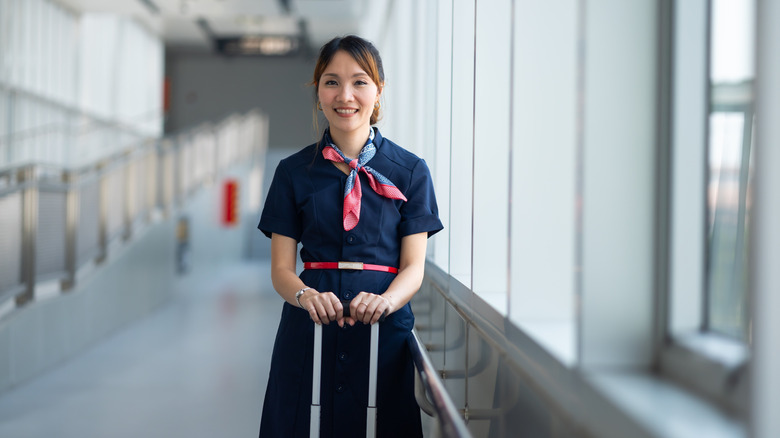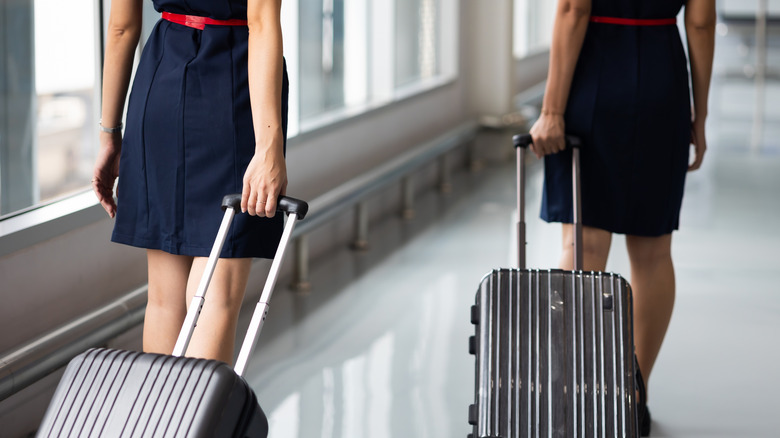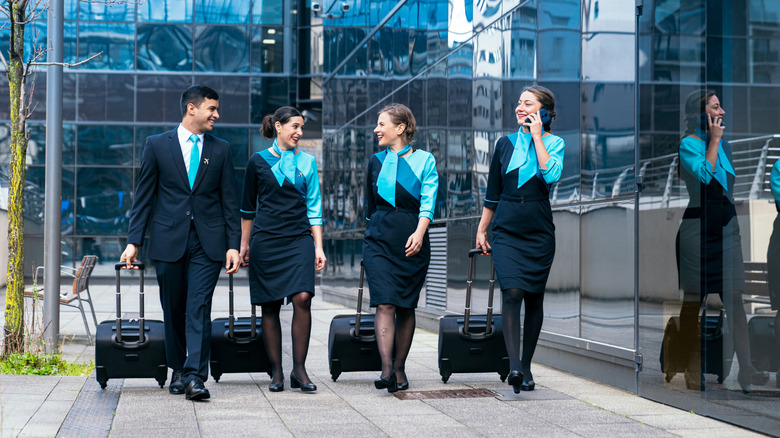What Free Flights Really Mean For Flight Attendants
Being a flight attendant is a specialized role and a dream gig for travel hopefuls wanting to build a career on wanderlust. As a result, the career path invites a lot of speculation and lore. On the one hand, there are the unusual rules and requirements for being a flight attendant, including strict guidelines regarding appearance (did you know some airlines prohibit their attendants from having braces?), as well as uncompromising requirements for physical fitness. On the other hand are the unique benefits, such as marking off bucket-list destinations during the 9-to-5 — figuratively speaking, of course, as odd hours are usually a given for the job — and even the promise of free travel off the clock.
We wanted to get the scoop on that last perk. Are free flights for flight attendants as luxurious as they sound? To separate fact from fiction, we spoke with Barbi, a journalist and veteran flight attendant. Having enjoyed a 40-year career in the skies, she's well acquainted with the realities of the role, from the less-than-glamorous responsibilities to the best parts of the job. According to her, free flights are a pretty sweet deal for flight attendants, as long as they manage their expectations.
Speaking exclusively with Islands, Barbi says nearly every U.S. carrier offers free flights for flight attendants, along with all their airline employees, but that's not all. "[Employees'] spouses/domestic partners, children, and sometimes parents can also fly for free on their own airline flights," Barbi explains. "Even retirees continue to keep their travel benefits after they retire, although they go at a lower standby status than current employees." As wonderful as that sounds, making the most of the perk comes down to your willingness to embrace "standby status."
The pros and cons of free standby flights for flight attendants
Standby status means "we 'stand by,' waiting to see if there will be any seats available after all the paying passengers have boarded," Barbi explains, speaking exclusively with Islands. "If the flight is full and all paying passengers have shown up for the flight, then the standbys do not get on and have to wait for another flight," she says. There are also rankings within standby status to determine who gets the free seat. "Some airlines use the first-come, first-served model, meaning the system processes standby clearances in the order employees checked in," Barbi says. Alternatively, she explains, other airlines operate on a seniority model, where senior employees are given preference over newer ones.
Another big caveat deals with how each airline fills its aircraft. For example, as the veteran flight attendant explains, "Some airlines oversell their flights by a lot, or others offer free standby changes for paying passengers, which allows for these passengers to switch flights, thus bumping (as it's called in the industry) the non-revenue, aka employee standbys." A flight attendant wanting to hop on a flight might also get bumped by those last-minute discounts airlines offer to try to fill flights. But Barbi says this is just part of the deal. While there are a few hoops to jump through, perhaps the best part of the free flights perk is that there is usually no limit to how often flight attendants can use their privileges on their airline, and they may even get to keep the perk for life. As long as a seat is available, a flight attendant generally has the opportunity to use it to jet-set to their next destination, including the secret list of locations flight attendants love to vacation.
Alternative travel perks to standby status for flight attendants
According to Barbi, standby status isn't the only way to snag a seat on the cheap as a flight attendant. She tells Islands that most airlines also offer discounted tickets to their attendants if they prefer to purchase a confirmed ticket instead of flying standby. Another travel perk that may surprise you involves reciprocal agreements, where airlines often offer heavily discounted, or even free, flights for flight attendants working for other airlines. "However, your boarding priority is lower than that of the airline's employees," Barbi says.
Yet another option available to flight attendants is what they call "riding jumpseat." "The cockpit and cabin have extra seats, which allow for flight crews to standby for that as well if they want," Barbi explains. "Pilots get the cockpit jumpseat and flight attendants get the one in the cabin." She says many pilots and flight attendants use this option as a way to commute to work when they don't live in the same city as their airline's hub. As long as you don't mind hopping on a flight just to get to work, potentially on a red-eye or across time zones, it's a way to make the job even more flexible. "It ... means we do not have to live in the city where our airline is based," Barbi says. It's an option she has utilized frequently throughout her career. All in all, while not quite as glamorous as it seems, the ability to fly free or for a fraction of the market price is a great perk for flight attendants, so long as you understand the rules. "It's a trade-off," Barbi shares. "Fly for free, but make backup plans for when things don't go as planned."


